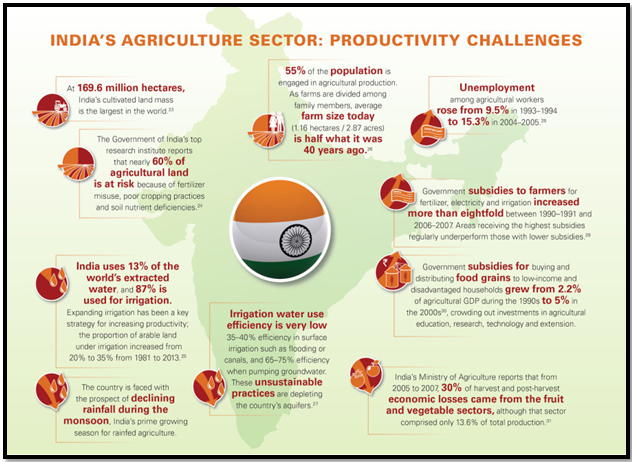A CALL FOR COMPREHENSIVE AGRICULTURAL POLICY
Syllabus:
GS 3:
- Agricultural Produce and Issues and Related Constraints
- Agricultural Policy.
Focus:
The need for a new agricultural policy in India is highlighted by recent events such as the contentious farm laws and their subsequent repeal. The government’s efforts to rebuild trust and address the complex challenges facing the agricultural sector have made this issue a focal point of national discussion.
Source: JustAgri
Need for a New Agricultural Policy in India
- Policy Paralysis: Existing policies are outdated and ineffective, leading to stagnation in the agricultural sector.
- Farmer Trust: Recent policy missteps, like the contentious farm laws, have eroded trust among farmers, necessitating sensitive and inclusive reforms.
- Global Competitiveness: Unlike other major economies, India lacks a dynamic agricultural policy, hindering its global competitiveness.
- Strategic Autonomy: Shifting focus from self-sufficiency to strategic autonomy is crucial for sustainable agricultural growth.
- Agro-Climatic Diversity: Policies must account for India’s diverse agro-climatic conditions to be effective.
- State-Central Coordination: Improved coordination between state and central governments is needed for cohesive policy implementation.
- Economic Viability: Enhancing the economic viability of farming through better pricing mechanisms and financial support is essential.
- Inflation Control: Revising outdated inflation control policies that disproportionately impact farmers is necessary for balanced economic growth.
National Agriculture Policy (2000)
|
Constraints and Structural Issues
- State Domain: Agriculture and land fall under state jurisdiction, limiting central government policy influence.
- Separate Ministries: Animal husbandry and fisheries, showing real growth, are under different ministries, complicating unified policy efforts.
- Budgetary Control: The Ministry of Finance controls budget allocations, restricting financial flexibility for agriculture initiatives.
- Inflation Policy: Outdated inflation policies dictated by the RBI further complicate effective agricultural policymaking.
- Drought Risks: Although India has avoided major droughts recently, the possibility of facing one in the next five years is high.
- Inflation Targeting: Convincing the government and RBI to change their inflation targeting methodology remains a significant challenge.
Challenges Facing New Agri Policy
- Policy Paralysis: The new Union Minister of Agriculture, Shivraj Singh Chouhan, inherits a legacy of policy stagnation that he must address.
- Farmer Trust: Rebuilding trust with farmers is crucial, especially after the contentious rollout of the three farm laws.
- MSP Committee: Scrapping the controversial MSP committee is a necessary step to begin sensitive handling of the situation.
- Lack of Policy: Unlike the US, EU, and China, India has not updated its agriculture policy for decades, highlighting the need for a new approach.
- Strategic Autonomy: The new policy should focus on achieving strategic autonomy rather than merely aiming for self-sufficiency.
- Diverse Conditions: The policy must account for the diverse agro-climatic regions and the federal structure affecting agriculture.
Impact of Inflation Targeting
- Consumer Focus: RBI’s focus on consumer price index (CPI) in a country where food constitutes 40% of the expenditure basket puts pressure on food prices.
- Lower Farmgate Prices: The effort to control food prices often leads to lower farmgate prices, negatively impacting farmers.
- Income Challenge: Lower farmgate prices make it difficult to improve farmer livelihoods and double their incomes.
- Commodity Policies: Government actions around non-essential commodities like onions reveal convoluted policies that hurt farmers.
- Price Control Impact: Artificially lowering prices leads to significant financial losses for farmers, as seen in the onion price example.
- Farmer Compensation: The government should introduce mechanisms to compensate farmers when policies depress farm gate prices.
Proposed Solutions and Reforms
- Direct Benefit Transfers: The government and RBI should devise methods like direct benefit transfers (DBT) to soften the impact of rising food prices on consumers.
- Compensation Mechanisms: Developing a system to compensate farmers for losses due to policy-induced price controls is essential.
- Documenting Failures: Policymakers should document policy failures to learn from past mistakes and avoid repeating them.
- Transparency and Accountability: Improving regulation, enforcement, governance, transparency, and accountability is crucial for policy success.
- Addressing Policy Errors: Acknowledging and correcting unforced policy errors and missed opportunities is vital for future progress.
- Lessons from the Farm: Policymakers must recognize that perfect solutions do not exist and strive to find acceptable levels of imperfection in policies
Conclusion
A comprehensive new agricultural policy is essential for addressing the diverse challenges of the Indian agricultural sector. By focusing on strategic autonomy, economic viability, and improved coordination, India can ensure sustainable growth and better livelihoods for its farmers, while maintaining global competitiveness.
Source:Indian Express
Mains Practice Question:
Discuss the necessity for a new agricultural policy in India. Highlight the challenges faced by the agricultural sector and suggest measures that can be included in the policy to address these challenges effectively.
Associated Article:




